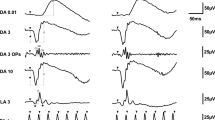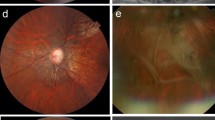Abstract
Topical anesthetics are recommended when electroretinograms (ERGs) are recorded using contact lens electrodes. However, these drugs act by blocking voltage-gated Na+ channels. Since such channels have been located in both the inner and outer retina of many species, topical anesthesia could affect the ERG recordings in these subjects. The purpose of this study was to evaluate the effects of oxybuprocaine, a commonly used ester local anesthetic, on the rat ERG. Full-field scotopic and pattern ERGs (PERGs) were recorded successively from both eyes of seven rats. One eye was randomly treated with oxybuprocaine 15 min prior to recording. In 10 rats unilateral full-field photopic ERG recordings were conducted prior to, and 15 min after, treatment. B-wave amplitude ratios of the experimental/control eyes were 1.13, 1.30, and 1.35 for the three intensities used to record scotopic ERG responses, and 1.04 for the photopic ERG responses. PERG amplitude ratios of the experimental/control eyes were 1.10, 1.21, 1.21, 1.24, and 1.26 for the five patterns used. Treatment had no significant negative effect on signal amplitude or implicit time of the full-field ERG or PERG. In fact, amplitudes of signals from treated eyes tended to be (insignificantly) higher, though this might reflect better position of the active electrode rather than a biological effect. We conclude that oxybuprocaine has no negative effect on the rat ERG.






Similar content being viewed by others
Abbreviations
- Nav :
-
Voltage-gated sodium
- TTX:
-
Tetrodotoxin
References
Marmor MF, Holder GE, Seeliger MW, Yamamoto S (2004) Standard for clinical electroretinography (2004 update). Doc Ophthalmol 108:107–114. doi:10.1023/B:DOOP.0000036793.44912.45
Parkinson J, Tremblay F (2008) Obtaining a contact lens acquired electroretinogram in the presence of topical anesthetic hypersensitivity. Doc Ophthalmol 116:245–249
Holder GE, Brigell MG, Hawlina M, Meigen T, Vaegan , Bach M (2007) ISCEV standard for clinical pattern electroretinography (2007 update). Doc Ophthalmol 114:111–116. doi:10.1007/s10633-007-9053-1
Holder GE (2006) The pattern electroretinogram. In: Heckenlively JR, Arden GB (eds) Principles and practice of clinical electrophysiology of vision, 2nd edn. The MIT Press, Cambridge/London, pp 341–352
Arden GB, Hogg CR, Holder GE (1994) Gold foil electrodes: a two-center study of electrode reliability. Doc Ophthalmol 86:275–284. doi:10.1007/BF01203551
Wilson G, Fullard RJ (1988) Cell sloughing with proparacaine. J Am Optom Assoc 59:701–702
Penna EP, Tabbara KF (1986) Oxybuprocaine keratopathy: a preventable disease. Br J Ophthalmol 70:202–204. doi:10.1136/bjo.70.3.202
Asensio I, Rahhal SM, Alonso L, Palanca-Sanfrancisco JM, Sanchis-Gimeno JA (2003) Corneal thickness values before and after oxybuprocaine 0.4% eye drops. Cornea 22:527–532. doi:10.1097/00003226-200308000-00008
Nam SM, Lee HK, Kim EK, Seo KY (2006) Comparison of corneal thickness after the instillation of topical anesthetics: proparacaine versus oxybuprocaine. Cornea 25:51–54. doi:10.1097/01.ico.0000179929.97651.59
Mojumder DK, Frishman LJ, Otteson DC, Sherry DM (2007) Voltage-gated sodium channel alpha-subunits Na(v)1.1, Na(v)1.2, and Na(v)1.6 in the distal mammalian retina. Mol Vis 13:2163–2182
Kawai F, Horiguchi M, Suzuki H, Miyachi E (2001) Na(+) action potentials in human photoreceptors. Neuron 30:451–458. doi:10.1016/S0896-6273(01)00299-9
Brown KT, Wiesel TN (1961) Localization of origins of electroretinogram components by intraretinal recording in the intact cat eye. J Physiol 158:257–280
Liang C, Peyman GA, Sun G (1998) Toxicity of intraocular lidocaine and bupivacaine. Am J Ophthalmol 125:191–196. doi:10.1016/S0002-9394(99)80091-9
Lincoff H, Zweifach P, Brodie S, Fuchs W, Gross S, Kornmehl E et al (1985) Intraocular injection of lidocaine. Ophthalmology 92:1587–1591
Anders N, Heuermann T, Rüther K, Hartmann C (1999) Clinical and electrophysiologic results after intracameral lidocaine 1% anesthesia: a prospective randomized study. Ophthalmology 106:1863–1868. doi:10.1016/S0161-6420(99)90394-9
Kuhlmann O, Stoldt G, Struck HG, Krauss GJ (1998) Simultaneous determination of diclofenac and oxybuprocaine in human aqueous humor with HPLC and electrochemical detection. J Pharm Biomed Anal 17:1351–1356. doi:10.1016/S0731-7085(98)00009-0
Ohguro H, Ogawa K, Maeda T, Maeda A, Maruyama I (1999) Cancer-associated retinopathy induced by both anti-recoverin and anti-hsc70 antibodies in vivo. Invest Ophthalmol Vis Sci 40:3160–3167
Ohguro H, Ogawa K, Maeda T, Maruyama I, Maeda A, Takano Y et al (2001) Retinal dysfunction in cancer-associated retinopathy is improved by Ca(2+) antagonist administration and dark adaptation. Invest Ophthalmol Vis Sci 42:2589–2595
Layton CJ, Chidlow G, Casson RJ, Wood JP, Graham M, Osborne NN (2005) Monocarboxylate transporter expression remains unchanged during the development of diabetic retinal neuropathy in the rat. Invest Ophthalmol Vis Sci 46:2878–2885. doi:10.1167/iovs.04-1458
Ben-Shlomo G, Bakalash S, Lambrou GN, Latour E, Dawson WW, Schwartz M et al (2005) Pattern electroretinography in a rat model of ocular hypertension: functional evidence for early detection of inner retinal damage. Exp Eye Res 81:340–349
Gouras P, Niemeyer G (1973) Rod and cone signals in S-potentials of the isolated perfused cat eye. Vision Res 13:1603–1612. doi:10.1016/0042-6989(73)90017-5
van Wart A, Boiko T, Trimmer JS, Matthews G (2005) Novel clustering of sodium channel Na(v)1.1 with ankyrin-G and neurofascin at discrete sites in the inner plexiform layer of the retina. Mol Cell Neurosci 28:661–673. doi:10.1016/j.mcn.2004.11.012
Lipton SA, Tauck DL (1987) Voltage-dependent conductances of solitary ganglion cells dissociated from the rat retina. J Physiol 385:361–391
Pan ZH, Hu HJ (2000) Voltage-dependent Na(+) currents in mammalian retinal cone bipolar cells. J Neurophysiol 84:2564–2571
Kasuya F, Igarashi K, Fukui M (1987) Metabolism of benoxinate in humans. J Pharm Sci 76:303–305. doi:10.1002/jps.2600760408
Sánchez-Chávez G, Salceda R (2001) Acetyl- and butyrylcholinesterase in normal and diabetic rat retina. Neurochem Res 26:153–159. doi:10.1023/A:1011098829378
Acknowledgments
This study was funded by the Joseph Alexander Foundation and the Alberto Moscona Foundation.
Author information
Authors and Affiliations
Corresponding author
Rights and permissions
About this article
Cite this article
Sandalon, S., Ofri, R. The effect of topical anesthesia on the rat electroretinogram. Doc Ophthalmol 118, 101–108 (2009). https://doi.org/10.1007/s10633-008-9141-x
Received:
Accepted:
Published:
Issue Date:
DOI: https://doi.org/10.1007/s10633-008-9141-x




